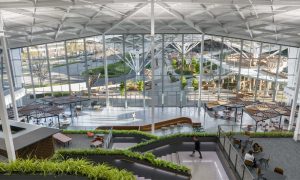Windows work: How natural light can boost morale in the office
Big Project ME speaks to lighting experts to find out how mimicking natural light can help improve worker performance in closed environments

Numerous studies have preached the positive effects of natural light in the workplace. In the scientific community, it’s close to an accepted fact that workers in windowless spaces tend to underperform compared to those who have access to plenty of natural light.
Back in 2013, researchers at the Interdepartmental Neuroscience programe at Northwestern University in Chicago released a study that highlighted just how detrimental working in a windowless environment can be. Titled Impact of Workplace Daylight Exposure on Sleep, Physical Activity and Quality of Life, the study highlighted the strong relationship between workplace daylight exposure and office workers’ sleep, activity and quality of life.
It found that compared to workers in offices without windows, those with windows received 173% more white light exposure during work hours and slept an average of 46 minutes more per night. Workers without windows scored lower than their counterparts on quality of life measures related to physical problems and vitality, while also registering poorer outcomes in measures of overall sleep quality, efficiency, disturbances and daytime dysfunction.
“The extent to which daylight exposure impacts office workers is remarkable,” says Ivy Cheung, the study’s co-author. “Day-shift office workers’ quality of life and sleep may be improved via emphasis on light exposure and lighting levels in current offices, as well as in the design of future offices.”
While there has certainly been a shift towards embracing natural light from a design and architectural perspective, lighting specialists and manufacturers have also embraced the change in outlook, offering products that mimic natural light and work in sync with circadian rhythms, says Regina Santos, associate at Godwin Austen Johnson.
“The positive effect of natural light on the wellbeing of people has been well documented. Artificial lighting systems that mimic daylight aim to improve our circadian rhythm and our biological response through the production of melatonin, the hormone that regulates our sleep cycles,” she tells Big Project ME.
“We tend to underestimate the importance of light on our wellbeing and just how much the light/dark cycle, or circadian rhythm, affects our moods. The availability of tuneable white light fixtures allows this to be implemented in projects today, improving the comfort and performance in work spaces and schools, as well as the quality of the overall ambiance. The improvement of lighting control systems, and the connectivity which allows people to have access to information and more control of their environment, are also part of the trend that makes this type of lighting application possible.”
One company making significant strides is Zumbotel, an Austrian light manufacturer. Its Active Light product range allows architects and interior designers to blend intensity, colour and direction at the right time to support the positive effects of natural light.
“Light is now regarded as a key factor and one of the most significant design elements for the satisfaction and motivation of employees in the workplace,” says Viet Mueller, SVP at Zumtobel MEIA. “A user study conducted by Zumtobel, in cooperation with the Fraunhofer IAO Research Institute, into the perceived quality of light in office workspaces has only served to emphasise this fact. In terms of light colour, the study also revealed different preferences based on age, working hours and individual type.”
“Technology will probably never be able to completely replicate the positive influence of nature. However, research into the impact of artificially created natural scenes has shown signs of a beneficial effect.”
Although Mueller concedes that office lighting products will always lack the dynamic change and adjustment of natural light, he points out that the Active Light range is oriented around natural daylight and the changes in colour temperature and intensity that occur during the day.
“In this way, we can provide optimal support for the human biorhythm. The default illuminance of 500 lux at the workplace stipulated by the standards is often perceived as insufficient, demonstrating how the lighting level should be increased for specific activities or at certain times of day.
“Technology can integrate changing light colours into the lighting scenario as a highly effective design element. That means cold-white lighting moods until early afternoon, followed by lower-intensity warmer light hues as evening approaches. New possibilities in terms of digitisation and controls also open further opportunities, helping the light of the future automatically adapt to particular tasks and respond spontaneously to gestures and groups of people,” he asserts.
Sergio Padula of iGuzzini adds that the Italian lighting firm has been conducting research into the field of biodynamics since 1988, aiming to understand the relationship between light and human biology. The results have informed and inspired the company to produce systems and products that have delivered significant results.
“The studies carried out with the Lighting Research Centre of Troy were based on the relationship between the variation of light features and the circadian rhythms of living beings,” he says. “In 1992, our studies gave origin to a patent and a biodynamic lighting system used to reproduce the natural variations of daylight in artificial spaces.”
“Not only was the system able to improve life and work quality in enclosed spaces such as control rooms of petrochemical plants and call centres, but it also contributed to the rehabilitation activities of patients who had just come out of a coma,” he asserts.
With the results confirming iGuzzini’s initial hypothesis – that a dynamic lighting system capable of generating biologically significant light will improve work performance, compared with a constant lighting system – Padula says targeted use of light makes it possible to stimulate the human organism.
“The discoveries made by photobiology at the time were already suggesting revolutionary ways of using artificial lighting. Experimental tests proved that the functions of the human body are regulated according to circadian rhythms.
“The most interesting results to emerge from this chrono biological research related to confined environments (submarines, underground environments, hyperbaric chambers, space capsules, artistic laboratories), precisely because sunlight is completely excluded from these places. The absence of sunlight not only weakens our organism, but also weakens our capacity to perceive our surroundings and influences our entire being, including from an emotional point of view.”
It’s easy to see now why light is now regarded as such a key factor in the design and development of office spaces. Mueller adds that the technology can go even further, with users taking active control of their environment.
“Today’s technology can ensure more user-focused and user-friendly operation of luminaires,” he says. “For example, at the Zumtobel Group office, every desk cluster is able to control its lighting individually. Employees can dim their cluster’s lights up or down by simply using their smartphones or computer desktops, and in some clusters they can even choose the colour temperature they prefer.”
The initial setting in a cluster imitates the natural rhythm of daylight. The day starts with a very warm 2,700 Kelvin in the early morning, simulating the sunrise. From 7am towards lunchtime, the colour temperature gradually adjusts to 4,000-5,000 Kelvin, synchronising circadian rhythms and suppressing melatonin release. Towards the end of the day, the lighting turns warmer again, allowing the release of melatonin and preparing the body for the rest phase.
“This is possible through intelligent lighting controls and sensors, which are furthermore crucial to maximise energy savings. Looking at the specs and designs of future projects, the Middle East is making progress on including intelligent sensors and controls, and we can finally see a larger shift towards using LED technology.
“Regardless of the application – whether art and culture, hospitality and wellness, office, industry and engineering, or presentation and retail – products can be developed specifically to help all industry professionals, be it the operator, the owner or the MEP contractor, to choose the right product for the right application,” he concludes.

























